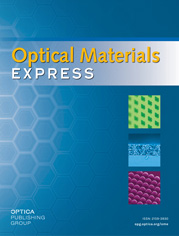
Optical Materials Express (OMEx) Emerging Researcher Best Paper Prize
OMEx attracts submissions from a wide range of optical and materials scientists, at all stages of their careers. As a forum for interdisciplinary research in current and emerging topics, the Editors want to particularly recognize the work of emerging researchers who publish in OMEx. With this in mind, they have created the OMEx Emerging Researcher Best Paper Prize.
This Prize recognizes one outstanding paper published in the Journal by an emerging researcher each year. The recipient is selected by a committee of OMEx Associate Editors representing a range of topics across the scope of the Journal and the criteria include significance, quality, and presentation. The Prize consists of a certificate and waiver of a future publication fee in OMEx.
To be eligible for the Prize, the first author of the paper must be a student or early-career researcher within five years of earning their highest degree.
Nominations are open in January of each year.
2022 Best Paper Prize Winner

Philipp Karl
University of Stuttgart, Germany
The authors present a class of superconducting nanowire single photon detectors that rely on resonant plasmonic perfect absorber effects to attain high fidelity and efficiency. The editors were particularly impressed by the ingenuity of the proposed approach for the realization of highly efficient nanowire photodetectors, the thoroughness of the experimental analysis, and the clarity of the presentation. Read more.
Previous Best Paper Prize Winners

2021
Julie Carcreff
Université de Rennes, France
Mid-infrared hollow core fiber drawn from a 3D printed chalcogenide glass preform
The paper describes a method of making chalcogenide glass fiber pre-forms via 3D printing. This proof of concept could enable fabrication of chalcogenide and other soft-glass based components such as optical fibers, especially hollow-core MOFs, and also types of other waveguides or lenses. The selection committee found the innovative use of 3D printing methods for a new application and the meticulousness of the study particularly notable. Read more.

2020
Simon Woska
Karlsruhe Institute of Technology, Germany
Tunable photonic devices by 3D laser printing of liquid crystal elastomers
The article reports 3-D laser printing of liquid crystal elastomers, a group of polymers that reversibly deform in response to external stimuli such as temperature and light. The selection committee was particularly impressed by the demonstration of tunable photonic devices based on this unique, active platform, and the thorough, in-depth discussion. Read more.

2019
Luis Marcelo Lozano
Massachusetts Institute of Technology, USA
This paper discusses the development of organic-inorganic films that simultaneously provide ultra-light weight, conformability, either visual coloring or transparency on demand, and passive thermal management via both conduction and radiation. The selection committee chose this paper due to the significant impact the results may have on thermal engineering as well as the thoroughness and depth of the work. Read more.

2018
Jiajiu Zheng
University of Washington, USA
This article described the design, fabrication, and characterization of silicon microresonators integrated with Ge-Sb-Te phase-change materials, and demonstrated nonvolatile switching of the devices through phase change. The level of depth and detail and the quality of writing, as well as the prospect of the technology's application in optics and photonics, made this work worthy of the Prize. Read more.

2017
Christian Haffner
ETH Zurich, Switzerland
This work demonstrates a novel way to enhance the performance of electro-optic devices by operating near the absorption resonances of the nonlinear medium. The thoroughness of the study and the clarity of the presentation were factors in awarding this paper the inaugural Prize. Read more.
